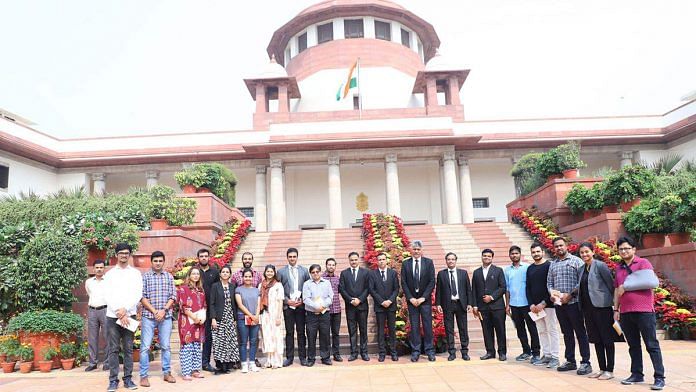Around 14 participants given a guided tour of the court, two days after CJI Ranjan Gogoi made the announcement in Judge’s Lounge.
New Delhi: As she traversed Court 1 in the Supreme Court, Divya Singh stopped to look at the life-sized portraits of Justice H. J. Kania, the first chief justice of independent India and Justice B. K. Mukherjea, the fourth CJI, that adorn the walls opposite each other.
The two men, however, weren’t the judges Singh was looking for. Her grandfather, Justice Mehr Chand Mahajan, had served as the country’s third CJI.
Also read: Supreme Court merely sniffing secret envelopes to see if there’s a scam in Rafale deal
Much to her chagrin, however, Singh was told that his portrait was, in fact, hanging on the walls in the judge’s corridor, which was out of bounds.
“Is it as big as the other photos?” she asked. Yes, came the answer in the affirmative.
On Saturday, Singh was among the 14 participants who were part of the maiden guided tour of the Supreme Court.
“I used to come here as a child, but this is the first time I am coming as an adult,” Singh told ThePrint. “At home, we used to take it for granted, but now, returning after so many years, I realise the stature of this place,” she added.
The tour took off two days after the Chief Justice of India, Ranjan Gogoi, made the announcement in the Judges’ Lounge at the apex court Thursday. The visit, which lasted 90 minutes, delivered on its promise and opened up the institution to the public in a “limited way”.
Queries aplenty
The 14 members of the public included a motley crew of students, bankers, lawyers of lower courts and professionals. They were picked from 120 applications.
The group, led court staff Manan and Sonia, who otherwise work in Secretary General Ravindra Maithani’s office, was taken across the 17 acres of the premises — the tour began at the Statue of the Mother and the Child in the front lawns and culminated at the Fountain of Justice in the backyard of the court building.
For some like Sunil Punshi, an executive working with Carl Zeiss, it was an opportunity to see how the court functioned. “I always saw the SC from outside, and I always wondered what it would be like to go inside,” he said.
As the group entered court number 1 – where the Chief Justice sits — Nivedita Das, 18, an English honours student with Delhi University said she had signed up for the tour after reading about it in the papers. “I love history and jurisprudence, hence this was a wonderful opportunity for me to experience both,” she said.
When the mini caravan made its way across the manicured lawns, Manan and Sonia stopped and pointed to the semi-circular shape of the main building. “The main building of the Supreme Court is in the shape of a balance,” they said. “The arms, east wing and the west wing, represent equality and the scale of justice, with the court of the chief justice at its head”.
The two were peppered with questions throughout, with queries ranging from the functioning of the court and the difference between a court of appeals and a trial court.
“It is not like the movies here,” a participant noted. “Here evidence is not presented,” the tour guide explained. Kapil Chawla, an advocate who was one of the participants, chipped in sharing his knowledge and experience.
Awe at the main building
As they made their way up the wide steps, towards the entrance to the courtrooms, necks craned upwards, eyes widened and a sense of awe and pride enveloped the group as it caught the first glimpse of the majestic dome rising before them.
“This place seems to have its own spirit and represents the epitome and power of state machinery,” Siddhartha Dutta, another participant, said.”
“This is where the judges enter court from,” Sonia said, as the group got a glimpse of the carpeted hallway that had staircases leading to doors with court numbers written next to it.
Also read: Judge who hailed Modi as ‘hero’ is among four new Supreme Court judges
The group then made its way towards the Judges’ Library – the second largest in Asia – where it was greeted by Dr. R. K. Srivastava, who heads it. After the briefing, lasting almost 30 minutes long, the group took the opportunity to look at a photo replica of the first edition of the Constitution of India.
An hour and a half later, the tour wound its way at the top court museum – which is open to the public.
The Fountain of Justice, located behind the Supreme Court building, was the last stop, bringing an end to the ‘experimental’ tour.
“This is our first attempt and we aim to refine the programme as we go along,” Rakesh Sharma, the top court’s Public Relations Officer who accompanied the group throughout the tour, said.




I never thought SC would wind up as a museum so soon. May be the retired CJIs crave for a re-emploment as curators. Well , shouldvthey not be content with simlar work all their term.
Prof PK Sharma, Freelance Journalist,Barnala(Punjab)
Quite innovative and novel initiatives paving way for eye-opening exposures and openness !
Unprecedented moves indeed to feed curiosity urges and to go in for never experimented acts earlier on !
The Honorable Apex Court must keep up this spirit in future too in the public interest !
Prof PK Sharma, Freelance Journalist
Pom Anm Nest Barnala(Punjab)
Very good article by Ratika.